Table of ContentsClose

Lindsey Knake: Embracing IT to improve neonatal care
Harnessing AI to help the most fragile newborns
After receiving her bachelor’s degree in biomedical engineering at the University of Iowa, Lindsey Knake, (15MD) ventured out on a winding path.
Knake stayed at Iowa to earn an MD degree at the Carver College of Medicine and then did residency training in pediatrics at the Baylor College of Medicine. She went on to complete a fellowship in neonatal-perinatal medicine and receive a master’s degree in biomedical informatics at Vanderbilt University Medical Center.
Knake’s training and experience eventually brought her back to Iowa with a refined purpose: embracing new technology to improve patient outcomes as a clinician, administrator, professor, and researcher.
Now as a clinical assistant professor and associate chief health information officer in the Stead Family Department of Pediatrics, Knake is working to improve outcomes for neonates, especially the most fragile preemies. She’s applying artificial intelligence (AI) tools to the task of analyzing data from electronic health records and bedside monitors used in the neonatal intensive care unit (NICU).
“It's all about how we can use technology to improve patient care, improve outcomes, and help with clinical decision support for physicians,” Knake says.
Her current research explores how AI can create models based on continuous data from bedside vital sign monitors and ventilators.

“We're recording and storing these data all the time,” she says. “As clinicians, we can't be at the bedside every second, and we can't always pick up on the subtle changes, like heart rate variability that is slightly different from two hours ago. The computer could potentially help us decipher warning signs if a patient is decompensating or when we should double-check that this patient doesn't have any infection before we try to wean them off the ventilator. In addition, AI may confirm the teams’ thought that a patient is clinically stable for extubation, which may result in getting them off the ventilator sooner.”
Knake notes that any patient care decision ultimately rests with the physician, but she hopes that further AI model development can provide insights into data that doctors can’t access currently. With this approach, she prefers to think of AI as “augmented intelligence” because it can bring an additional, unique set of skills to the delivery of care.
Knake is also collaborating on a research project with UI colleagues and researchers at the University of Missouri and the University of Chicago that’s using generative AI to review clinical notes to help create better discharge summaries for patients leaving the NICU or hospital.
“In Iowa, a lot of parents travel two or three hours if their baby's here in the NICU, and then they get their ongoing care closer to home,” Knake says. “We are trying to find ways to use AI to help summarize their infant’s six-month stay here in our NICU and provide that to the new physicians taking over their care.”
Another project that Knake and colleagues are trialing involves an AI voice-recognition and medical transcription tool called Nabla to help draft clinical notes based on physician conversations with patients. The HIPAA-compliant software uses speech-to-text technology to document a physician-patient interaction. From this documentation, the tool generates a draft note that a clinician can review, edit, and transfer to the patient’s medical record.
For each of these projects, Knake is bringing together several disciplines in a deliberate and thoughtful way.
“I see myself as the liaison between the computer scientists, the data scientists, the clinicians, and the IT specialists who are going to help us create and implement these algorithms,” she says. “How do we implement AI so clinicians trust these algorithms and can use them to augment—but not completely replace—their decision making? That's where I foresee the next frontier of AI research.”
Photos by Liz Martin
